
The Fire Emblem community: Elitists, casuals and everything in-between
The Fire Emblem series has become one of Nintendo’s most popular franchises worldwide over the last 8 years. The Japanese RPG strategy video-game series has been around since the early 1990’s but its community has only began to grow to a considerable size with the release of FE Awakening in 2012, which managed to sell over 2 million copies. Despite its long lifespan, dedicated following and critical acclaim, it would still not be accurate to call Fire Emblem a mainstream franchise, but it is undeniable that it has an ever-growing community shaped around it.
This article discusses how the franchise went from being Nintendo’s obscure Japanese exclusive series to the popular juggernaut it is today. It also provides a detailed analysis of various aspects of the Fire Emblem community, including what it takes to be a fan, where fans might be found, what types of fans there are, deviance outside and within the community, language quirks and other social traits.
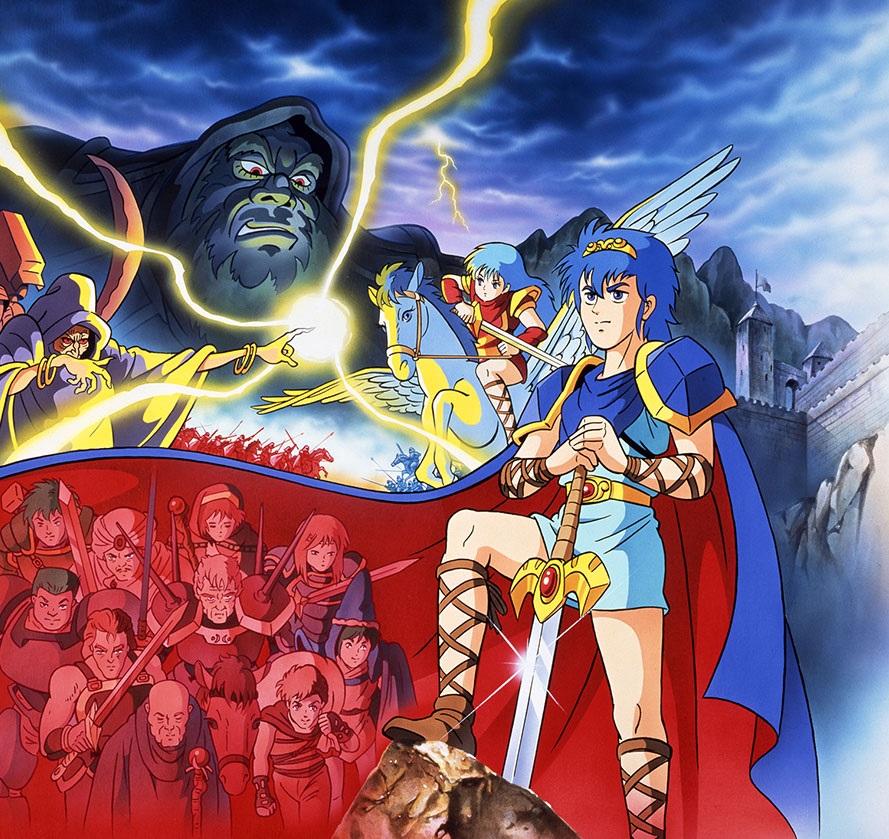
The cover art of the very first FE game, released in 1990: Shadow Dragon and the Blade of Light (ファイアーエムブレム)
History of the Fire Emblem franchise
Fire Emblem is a fantasy tactical role-playing videogame franchise developed by Intelligent Systems and published by Nintendo. The first instalment was released on April 20th, 1990 on the Famicon, the Japanese version of the Nintendo Entertainment System (NES). In its first years, the series received moderate commercial success but managed to make a name for itself for its compelling storytelling and hardcore strategic gameplay revolving around the infamous "perma-death" feature. This feature entails that when one of your characters loses all of its life points, they are permanently removed from the game and thus cannot be used in battle anymore. Ultimately, this was also the reason why Nintendo decided to keep the franchise exclusive to Japan as it would have been supposedly too difficult for a Western audience to beat.
In 2001, Fire Emblem saw its first instance of recognition in the Western world when the main characters Roy and Marth were introduced as playable fighters in the massively popular Nintendo mash-up fighting game Super Smash Bros Melee. While the general audience had no clue who these characters were, simply referring to them as "anime swordfighters", this did spark some interest in the franchise.
Finally, 13 years after its launch Nintendo and Intelligent Systems (IS) decided to give FE a chance in the West: Fire Emblem, now referred to as "Fire Emblem The Blazing Blade", was released in North America, Europe and Australia. Although the game performed well both commercially and critically, sadly, the franchise did not manage to keep up this momentum in the following years as the sales progressively declined, leading to the 12th installment returning to being Japanese-exclusive and selling very poorly.
With this turn of events, the development studio IS was put under pressure. Supposedly, if the next game in the franchise did not sell more than 250,000 copies, the Fire Emblem series was going to be cancelled. This forced the game developers to think outside the box and shake up their formula. Whether or not the Fire Emblem franchise was truly threatened like that remains a topic of debate among fans, but one thing is for sure, the new approach worked.
The new game FE Awakening made the series more accessible by adding a "casual" mode which would remove perma-death, rendering the game easier for newcomers. It also focussed more on story elements and character development/bonding than ever before, in order to cater towards a broader audience.
This change left a lot of older fans scorned, but nonetheless the game sold better than ever before. This time, the producers used the momentum generated more appropriately as, in the following years, Fire Emblem became one of Nintendo’s flagship franchises across the world. The very popular FE Fates sold a combined 2.9 million units, and multiple spin-offs were created, most notably the FE Cipher Trading Card Game, and the gacha-like FE Heroes mobile game. The latter grossed 500 million dollars in its first 2 years and brought in a massive amount of new players to the franchise.
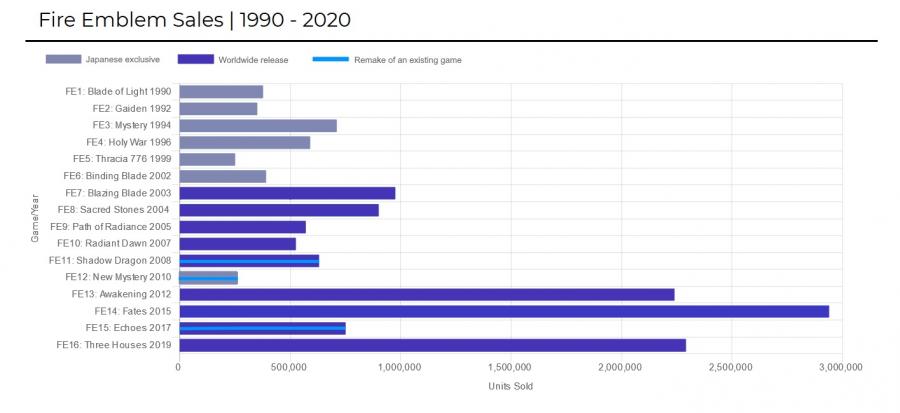
Fire Emblem game sales in unit amount (1990 - 2020)
Finally, we arrive at the present. The latest installment in the franchise FE Three Houses was released in June 2019 and it's looking to become the best-selling game in the series by a mile as it sold 2.3 million units in its first two months. The critically acclaimed game even managed to win a game award in the Best Strategy Game of 2019 category
With this consistent success over these past years, the Fire Emblem community has expanded to a considerable size. Now that FE's past struggles for becoming relevant in the Western hemisphere have been laid out, we will take an in-depth look at what goes on within the now established Fire Emblem fanbase. This historical overview of the franchise is necessary for understanding the multiple layers of the community.
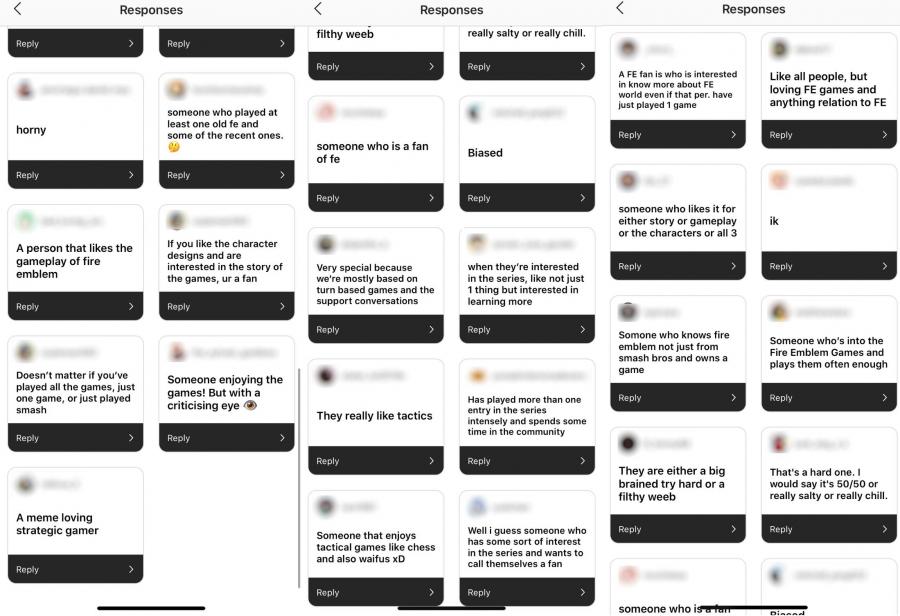
Responses of Instagram users asked how they would define an FE fan
What does it mean to be a Fire Emblem fan?
How does one become a member of the Fire Emblem community, and what does it take to be accepted as a true fan? Obviously there is no exact definition and almost every member of the community would answer this question differently. When this question was posed to a Fire Emblem community on Instagram, answers varied greatly, as expected. Some people value the gameplay elements above everything else, others value the story and characters more, some say you need to have played a certain set of games in the franchise and others would say that just enjoying the mobile game is enough.
So, does this mean that you need to like every aspect of the FE games to be considered a fan or are a few elements enough?
A fair description of someone who would be considered a fan of the franchise in everyone's eyes would be: someone who has played multiple games in the series, ranging from the older ones to newer entries, who enjoys the strategic gameplay, story and character elements while evaluating those aspects in a fun-oriented yet also critical matter.
Taking a lighter approach, we could describe a fan as: someone who has dived into the world of Fire Emblem, either via the main games or their numerous spin-offs, and who has enjoyed these in whatever way they feel accomplished in.
It stands to reason to assum that people who would fall under the latter description would turn into the category of fans described first over time, as they delved further into the franchise. These two statements could also be examined to reveal some discourses which underline who is (not) considered a legitimate fan of the series. For example, someone could not be considered a fan of the series if they had only played the mobile spin-off.
However, based on general community reception, community members who are heavily involved would fit into the first description. Further variation in fans' characteristics can be captured through the concept of enoughness (Blommaert & Varis, 2015). This means that if when someone checks off enough required traits, than they can be considered a Fire Emblem fan.
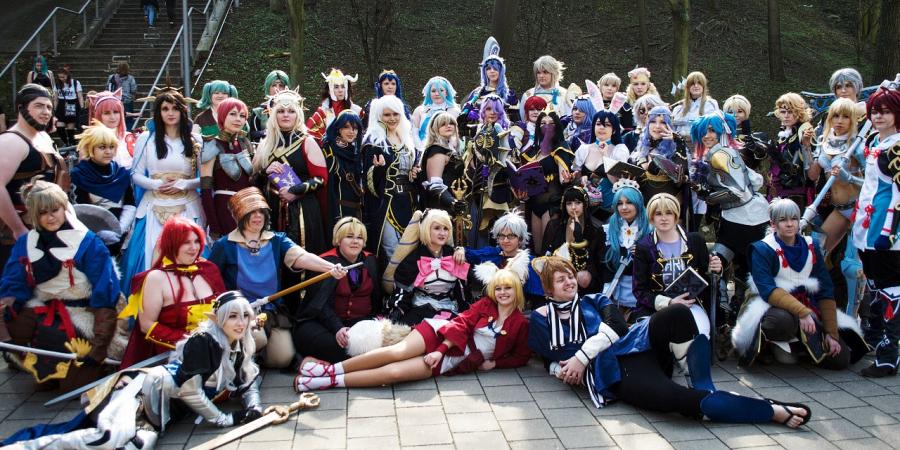
Dedicated FE cosplay fans gathering together at Leipzig Book Fair, Germany. Photo by Orion_Black on Animexx
Where is the Fire Emblem community found?
As a fairly large social group, the Fire Emblem fandom has its own infrastructures that allow for commodification. The FE community can be found primarily on various online social platforms. What kind of people you will find on those varies quite a lot per medium. This concentration of the FE fandom online renders it a micro-population with polycentric, layered and transnational communities (Maly & Varis, 2016). FE fans gather from around the globe on these platforms, which all have their separately-led communities who occasionally work together.
Rarely do you find a Fire Emblem fan who is solely dedicated to the FE community. Most members are fans of many other Nintendo franchises like Pokémon or Smash Brothers as well as gaming- or anime-related groups in general. The FE community is scattered all over the main social platforms of the web. Two of the largest FE communities are on Reddit and Amino. Instagram, Twitter, Tumblr and the old forum Serenes Forest are also frequently used. Discord is the main private messenger used.
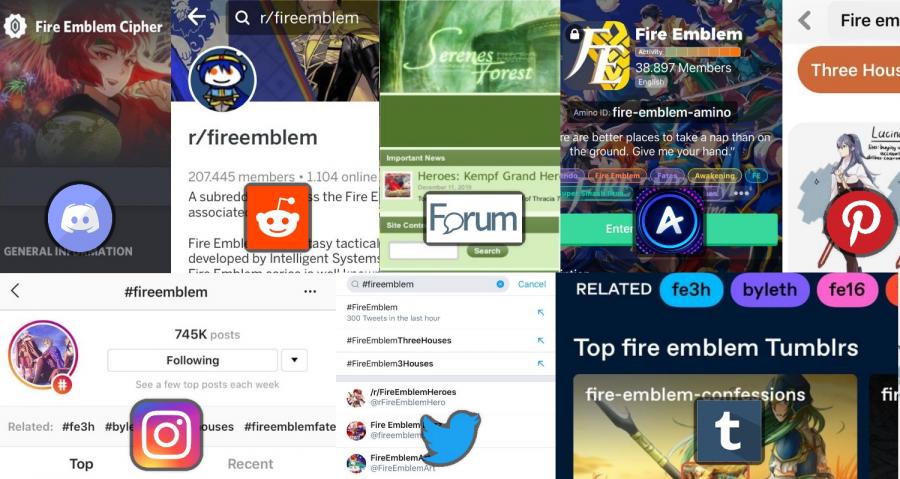
Different social platforms with an active FE community
Taking Reddit as an example, with over 200,000 members, the Fire Emblem subreddit is not only one of the largest FE communities you will come across but also one of the most diverse. Reddit is a platform where a lot of user-generated content gets shared for large audiences. Fan artists and cosplayers frequently post their work, threads are open to gameplay and character discussion and memes get shared like wildfire. FE’s mobile game called Heroes even has a separate community on this platform with 150,000 members.
Like Reddit, the Fire Emblem community on Amino serves many purposes. Many artists and cosplayers regularly upload their content there. Amino has more hardcore gameplay-oriented users as well. Quite a lot of fanfiction writers also find an audience here. Perhaps one of Amino’s largest differences is the amount of public/private direct messaging that goes on there. These chats allow each individual aspect of the franchise to flourish and opens up many ways of connecting on a personal level between fans. This also opens the door for a lot of roleplayers. Finally, just like Reddit, Amino also has quite a large community solely for FE Heroes fans.
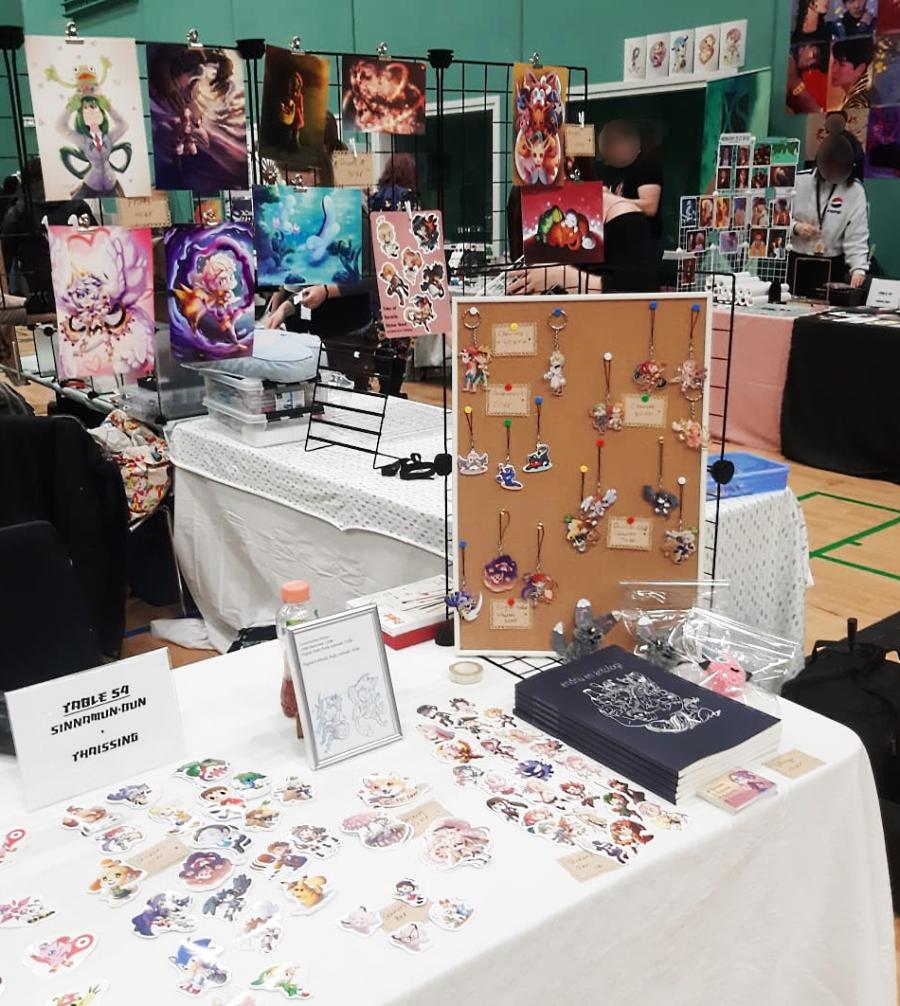
A fanartist selling FE merchandise DoKomi. Art by Tha1ssing on Instagram
While the Fire Emblem community can mainly be found online, they also organize a few offline gatherings. There is a yearly FE convention called "Fire Emblem Expo" in Japan, which started last year, organized by Intelligent Systems themselves.
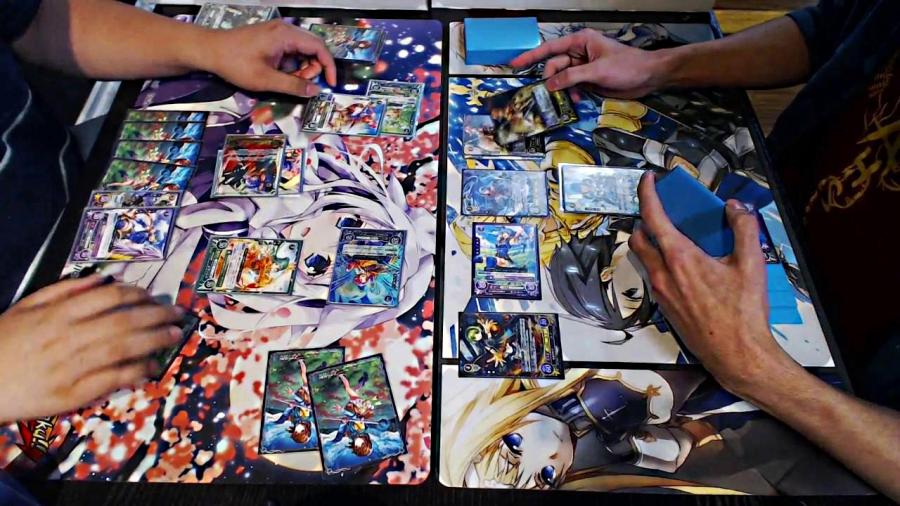
A Fire Emblem Cipher tournament. Chris L. vs. Randall M.
There are also quite a few official TCG tournaments held in Japan to play the card game, while all the tournaments outside of Japan are mostly fan-driven meet-ups. In the Western hemisphere, most fans of the franchise gather at general gaming/anime conventions. Most notably, there is an extremely dedicated vast group of Fire Emblem cosplayers who try to come together at various expositions in Germany.
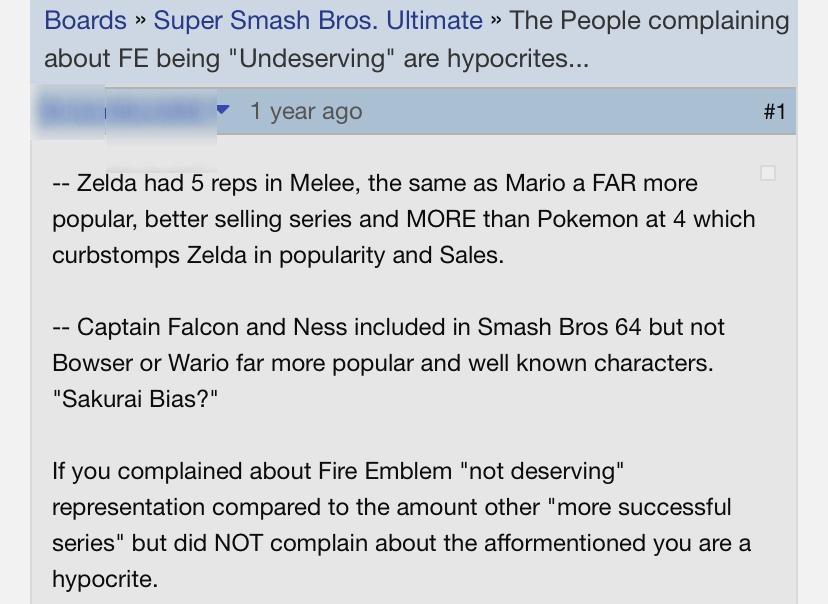
An FE fan responding to backlash from the Smash Bros community. Retrieved from GameFaqs
Deviance from other Nintendo franchises
Ironically, FE fans are mostly seen as deviant by fans of other Nintendo franchises like the Animal Crossing, Pokémon, but primarely the Smash Bros community. FE fans are often categorized as weebs, a term for a non-Japanese person who is so obsessed with Japanese culture that they wish they were actually Japanese.
These preconceptions are based on the fact that Fire Emblem has sported an anime-inspired art style for decades. Some may argue that this is hypocritical as all Nintendo games have Japanese origins and are filled with Japanese culture. While not true for everyone, these opinions are accurate to a degree, as a vast amount of FE fans are also anime fans.
As mentioned previously, almost all FE fans are also active within other Nintendo communities, causing some controversial debates to arise every now and then. The reason why some Smash Bros fans feel resentment towards the FE franchise, for example, is the perceived over-representation of playable FE characters in the Super Smash Bros crossover fighting series. This problem was amplified when another FE character got added very recently in January 2020.
Today, out of 80+ characters to play, 8 of them are from the FE series, which is significantly more representation than that of most other franchises, and many Smash fans feel like those spots could have been more deserved by other characters to create more diversity within the game.
Note, however, that at the end of the day, the people who are vocal about their prejudice are by far in the minority. The vast majority of Nintendo fans get along perfectly fine.

A rant about FE having too many characters in Smash. Retrieved from Reddit
Deviance within the FE community: Elitists vs. Casuals
Arguably a lot more frequent is deviance emerging within the fandom. While the different elements added to FE Awakening starting in 2012 made the series a lot more accessible to more people, it did split the fandom. Namely, the factom is now split in two factions: elitists and casuals.
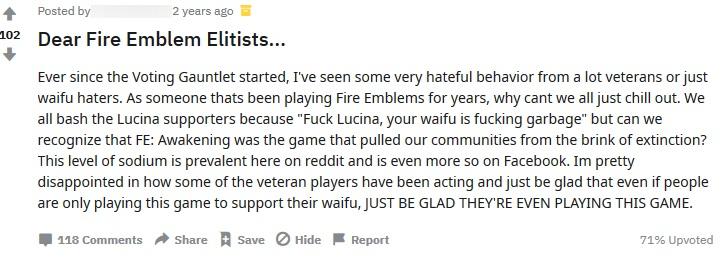
A post about Elitists. Retrieved from Reddit
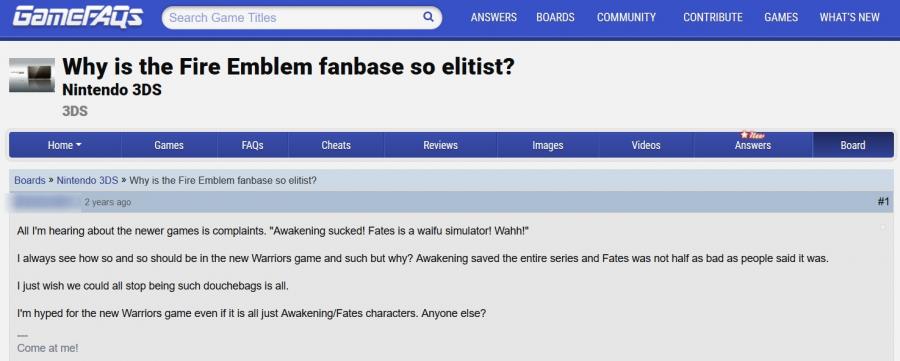
Someone questioning the FE fanbase. Retrieved from GameFaqs
An elitist is considered someone who has a lot of experience with the franchise, which is showcased by the many game entries they have played, including the Japanese entries via English-translated ROMs. This experience is also displayed in the way they play the games, with advance tactics, stat calculations and special challenges that make the games even more difficult.
The term "elitist" was generally applied to people who showed off their knowledge of the series, while excluding anyone who was not as familiar with the games. The term was often seen as an accomplishment among elitists themselves, but generally it was used in a more negative light by the rest of the community.
Meanwhie, a casual is someone very new to the series who is lacking in experience of the games, resulting in an unfamiliarity with a lot of the original elements of FE. It is generally presumed that they enjoy the story and character development elements of the franchise much more than the gameplay. They get tied to the 3DS era of games (2012-2017), games that are assumed to largely rely on simple strategies or the use of "casual" mode, which is what the term derives from, and which of course makes the game a lot easier to beat. This term was also often negatively, similarly to the general term "noob".

A memey explanation of different types of FE fans. Retrieved from Reddit
These terms had been thrown around a lot, until their use peaked with the release of the FE Fates games, which focussed even more on "casual" aspects. While elitists and casuals both are a minority within the community, this divide has managed to spark many debates among fans.
Both terms are being used considerably less in the last few years as more and more people move towards the centre of the discussion. Nowadays, they are more often used jokingly rather than as a real insult.
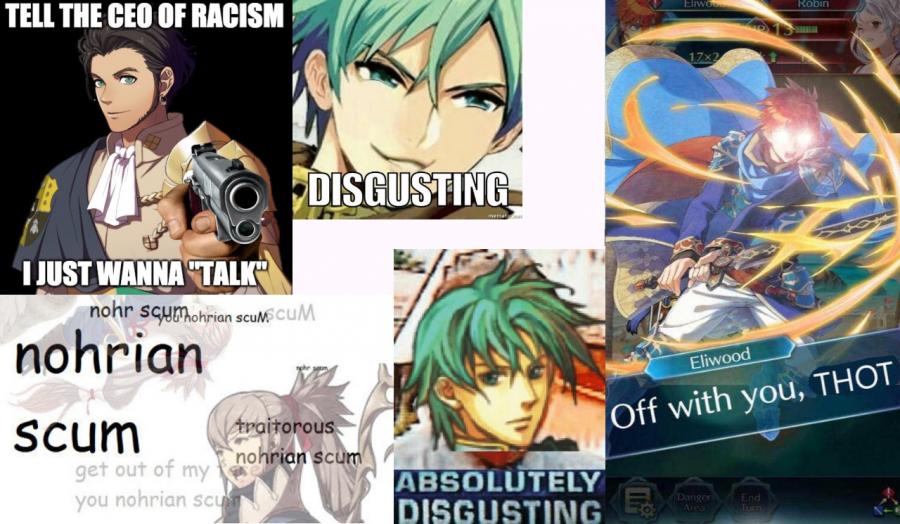
Popular FE memes. They are based on funny quotes by characters which have been memed. The racism meme originated from one of the characters striving for equality between the kingdoms.
Fire Emblem language: Memes, character quotes and stylization
According to Howard Becker (1963), one must master the language of a group in order to truly be a part of it. The main language FE fans communicate with is English, though a lot of fans also speak Spanish, Japanese and various European languages. Unlike many other communities, Fire Emblem fans do not have a distinctive super-vernacular (Blommaert, 2012) that is exclusive to them. This means that most language quirks are a mix-match of elements from different cultures and communities.
A lot of speech relies on currently relevant memes, like saying "F" to show sadness or "mood" to show that you relate. The word "nut" gets thrown around a lot as well, which is generally meant as "I like this a lot". Japanese emoticons are used sometimes too, primarily "uwu" which was originally meant to convey a sense of cuteness but has since been used jokingly more frequently. FE fans also ironically call each other "weeb" and "thot" a fair amount, mostly as an inside joke.
When looking at language specific to the community, the aforementioned terms "elitists" and "casuals" still get used a decent amount. More consistently, however, members use references to the games. "Nohrian scum", "*groans in discomfort*", "pick a god and pray!", "time to tip the scales!", "The enemy!", "disgusting" and "I’ll do my best!" all get used a lot. Most of these are direct quotes from characters in the game, which have a funny sound to them.
Lastly, there are some stylization practices that allow you to express yourself more lively through text. All of these are used by many other online communities as well. Asterisks are used to express an action being taken, for example: "*shakes hand*". This is primarily used by role-players but has found its way into normal messaging routines. Besides the obvious caps lock and cursive text, putting spaces between each letter is also often used to articulate a word or to joke around. An example would be: "H E L L O T H E R E".
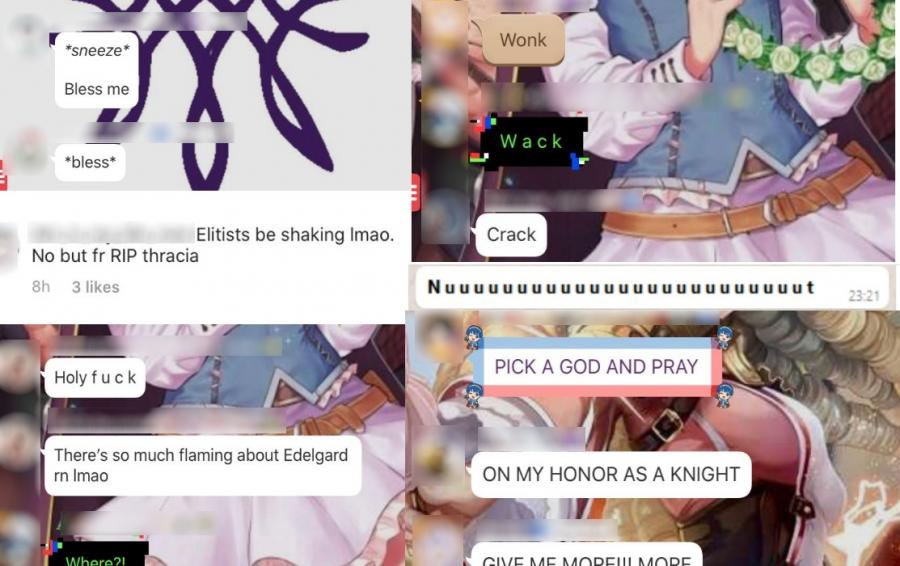
Different FE language traits
Fire Emblemless
Funnily enough, the Fire Emblem fandom does not use a lot of emblems to represent their identity even though there are so many different symbols that could be used. There is not a lot of official FE merchandise out there so you are not likely to see someone sporting a FE-themed shirt on the street. The only way FE fans could recognize each other before actually engaging in conversation would be via their bios or profile pictures on their social accounts. Sometimes, you can predict what kind of FE fan someone is based on their profile picture alone.
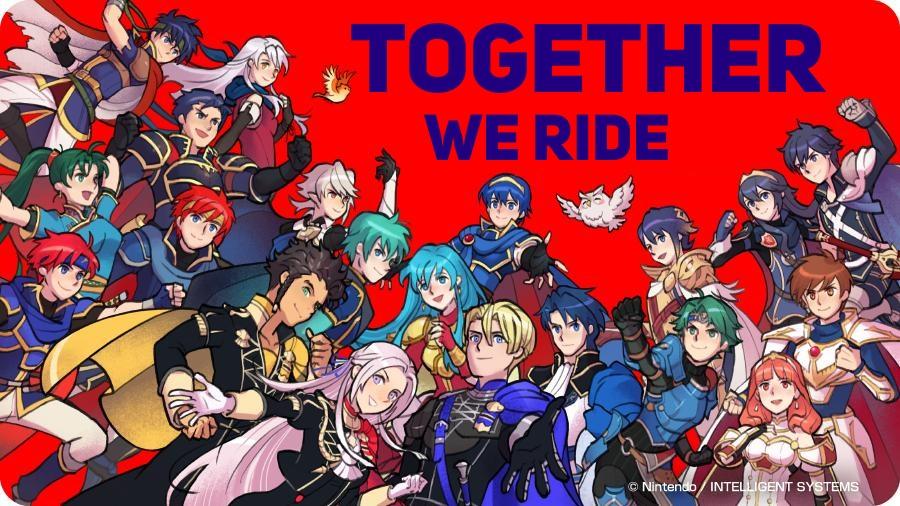
Promotional art for the FE Expo 2020
Together We Ride
The Fire Emblem community is likely to continue growing these coming years. It has already reached an impressive size for its niche subject and it has only grown with every release this passed decade. A community which was known for its toxic behaviour is also beginning to look a lot healthier, for which most people within the fandom surely are grateful for.
By focussing more on inclusion and collaboration instead of exclusion and segregation the community has become more open to newcomers than ever before. If they were to follow the meaning behind the title of one of the most popular theme songs from the games "Together We Ride", the community could leave their past segregation into elitists and casuals behind to create a fandom where anyone can thrive and express their love for the iconic tactical-roleplaying series.
References
Becker, H. (1963). Outsiders: Studies in the sociology of deviance. New York: The Free Press.
Blommaert, J. (2012) Super vernaculars and their dialects. Dutch Journal of Applied Linguistics. 1. 10.1075/dujal.1.1.03blo.
Blommaert, J. & Varis, P. (2015). Enoughness, accent and light communities: Essays on contemporary identities. Tilburg papers in Culture Studies 139.
Pink, S., Horst, H., Postil, J., Hjorth, L., Lewis, T., & Tacchi, J. (2016) Digital Ethnography: Principles and Practice. SAGE Publications Ltd.